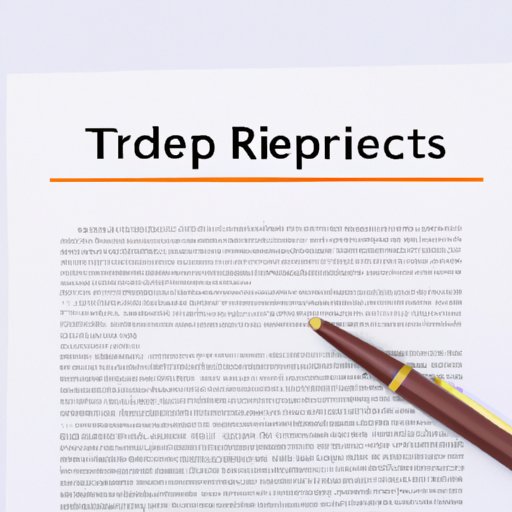
I. Introduction
If you have been asked to write a reference letter for someone, you may be wondering where to begin. A reference letter, also known as a recommendation letter, is an important document that can make or break a candidate’s chances of securing a job or admission to a program. In this article, we will guide you through the process of writing a compelling reference letter that highlights the candidate’s strengths, skills, and experiences.
II. The Art of Writing a Reference Letter
A reference letter is a formal document written by an individual who is qualified to evaluate the character, abilities, and achievements of the person being recommended. A reference letter should provide a balanced and objective assessment of the candidate’s qualifications for the specific job or opportunity. The format, tone, and content of the letter are crucial in conveying a strong and positive impression of the candidate. Tips for highlighting the candidate’s strengths include providing examples of specific accomplishments, using descriptive language, and avoiding vague or generic statements. It is important to tailor the letter to the specific job or opportunity to demonstrate how the candidate’s skills and qualities match the requirements of the position.
III. Top 5 Do’s and Don’ts of Writing a Reference Letter
Do’s:
- Be specific and provide concrete examples of the candidate’s skills and qualifications.
- Use strong, positive language that highlights the candidate’s strengths and potential.
- Be truthful and avoid exaggerating or misleading information.
- Structure the letter in a clear and logical way that is easy to read and follow.
- Proofread the letter carefully for errors and typos.
Don’ts:
- Be too generic or use cliches that do not provide meaningful information.
- Include irrelevant or too personal details about the candidate.
- Use negative language or mention any weaknesses or flaws of the candidate.
- Provide incomplete or inadequate information that does not support the candidate’s case.
- Include jargon or acronyms that may not be understood by the reader.
IV. How to Write a Reference Letter That Gets Results
To make your reference letter stand out from the rest, you can use strategies such as emphasizing the candidate’s unique qualities or experiences, using powerful and vivid language, and addressing any potential concerns or objections that may arise. You can also use bullet points or headings to make the letter more readable and scannable. Before writing the letter, it may be helpful to sit down with the candidate and discuss their goals, skills, and achievements to gain a better understanding of their strengths and how they might be presented in the letter.
V. Reference Letter Writing Tips for Different Jobs and Industries
The skills and experiences that are most valued in different fields can vary widely, so it is important to adapt the letter to the specific job or industry. For example, a reference letter for a teaching position may need to emphasize the candidate’s ability to work with children and their knowledge of different teaching methods, while a reference letter for a business position may need to emphasize the candidate’s leadership and analytical skills. When writing the letter, it can be helpful to research the requirements of the job and the company culture to ensure that your letter matches their expectations.
VI. What to Include in a Reference Letter for Graduate School
Graduate school applications often require reference letters from professors, advisors, or employers who can attest to the applicant’s academic ability, research potential, and personal character. In a reference letter for graduate school, it is important to address the applicant’s specific qualifications for the program, such as their academic achievements, research experience, and future goals. You may also need to address any potential weaknesses, such as low grades or gaps in their academic record, and explain how the applicant has addressed these concerns.
VII. Reference Letter Writing: A Step-by-Step Guide
If you are new to writing reference letters, the following step-by-step guide may be helpful:
- Start by introducing yourself and your relationship to the candidate.
- Briefly summarize the candidate’s qualifications and achievements.
- Provide specific examples of the candidate’s skills or experiences that are relevant to the job or opportunity.
- Highlight the candidate’s strengths and potential for growth or development.
- Address any potential concerns or challenges that may arise.
- End by summarizing your recommendation and expressing your confidence in the candidate’s success.
VIII. Common Reference Letter Mistakes and How to Avoid Them
Some common mistakes that people make when writing reference letters include being too negative or too positive, using jargon or acronyms that may not be understood by the reader, and failing to provide sufficient evidence or support for the candidate’s case. To avoid these mistakes, it is important to balance your assessment of the candidate with specific examples of their accomplishments and strengths, use clear and simple language that is appropriate for the audience, and provide evidence or documentation to support your claims. It is also helpful to proofread the letter carefully and ask for feedback from other colleagues or mentors.
IX. Conclusion
Writing a strong and effective reference letter can be a challenging task, but with the tips and strategies provided in this article, you can increase your chances of success. Remember to be specific, truthful, and balanced in your assessment of the candidate, while also highlighting their unique strengths and potential. By following these guidelines, you can help your candidate to stand out from the competition and achieve their goals.




